
Sacred Texts Native American Plains Index Previous Next
Buy this Book at Amazon.com


The Old North Trail, by Walter McClintock, [1910], at sacred-texts.com
Camp scenes of the first day.—An Indian mother's happy disposition.—Manner of inviting guests to a feast.—Old Morning Eagle exhibits his war horse.—His medicine songs at sunrise.—Natosin, a visiting chief from the North Blackfeet.—A Blackfoot cradle.—Varied industries of the women.—Their antipathy to the camera.—Their manufacture of tipis.—Training of girls by their mothers.—Curing of meat and making of pemmican by the women.—Diet of the Blackfeet.—A dog feast by visiting Assinniboines.
THE first day in the Sun-dance camp was warm and pleasant. The Indians remained outside their tipis greeting their friends and watching for late arrivals. All were light-hearted and glad to be assembled in the great tribal camp. On all sides were scenes of activity, boys galloping bareback over the hills while rounding up the horses, men picketing their horses and driving large herds of them to the lake for water. Women were arranging the lodges, caring for the medicine bundles and bringing in wood and water in preparation for the evening meal.
An inseparable feature of an Indian camp is the large numbers of dogs of all kinds. They mostly run in packs, continually brawling, or, for the sake of excitement, racing after horsemen and riderless horses on the hills, or even worrying a single dog that had incautiously ventured out alone.
Little Owl's large family were seated about an outside
fire in front of his lodge, while Poi-o-pa-ta-mach-ka (Coming Running) prepared their supper. She was young and very pretty, although the mother of a numerous flock of children. As my lodge was close by, I had an opportunity of observing her overburdened life. She was entertaining visitors from the Flathead tribe in her single-roomed home. A crowd of small children
 Click to enlarge COMING RUNNING. |
Wolf Chief came from his lodge to announce that he was giving a feast. He invited his guests by shouting each of their names several times in succession. The simplicity of this Blackfoot custom of issuing social invitations contrasts with the complicated forms observed in civilised society.
Morning Eagle, a noted old warrior and the hero of many battles, led through the camp his old white war-horse, decorated with medicine emblems and picture writings, representing his achievements in early days, while, in a loud voice he called the people's
attention to his "advertising horse," and proclaimed his deeds of valour. Although a very old man, he was still alive during the Sun-dance camp of 1909, when his lodge was close to mine. He was then nearly blind and had completely lost the use of his legs, but he still

Click to enlarge
LITTLE OWL'S FAMILY AROUND AN OUTSIDE FIRE.
(Coming Running is surrounded by children.)
retained his old-time enthusiasm and love of excitement. He had the young men lift him upon his war horse, that he might ride through camp as of old and take part in the sham battles. He awakened me every morning at sunrise (4.30), when he began to chant his medicine songs, repeating the performance at precisely the same time each day. The songs seemed very similar, the
principal variations consisting in changes of rhythm and in the different bird, or animal calls at the end of each. During a heavy storm, and in spite of his age
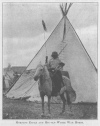
Click to enlarge
MORNING EAGLE AND HIS OLD WHITE WAR HORSE.
and feebleness, he crawled from the lodge on his hands and knees and seated himself in the pouring rain, with only a blanket thrown over his head, to pray and to chant medicine songs, for the purpose of driving away the storm.
Standing before his small tipi among the North Blackfeet, was an elderly chief named Natosin (Sun Chief). His two travois, one with a wicker frame constructed over the seat as a protection from the weather, were ingeniously raised together for a sun shade over the door. He was over six feet in height and of dignified bearing. His long hair was tinged with grey and his

Click to enlarge
NATOSIN'S TIPI AND TWO TRAVOIS.
face manly and earnest. He seemed pleased, when I stopped to tell him that I had once visited his people. At that moment his wife came from the lodge and joined in welcoming me. Natosin said, "We have come here in fulfilment of a vow. During the past winter, when very sick, I vowed that if my health was restored, I would attend the next Sun-dance. When we heard the ceremonial was to be given here, we came
from the far north, that I might fulfil my vow and that we might partake of the sacred food."
In another tipi I heard a woman singing softly. Looking within I saw a little hammock, ingeniously made by folding a blanket over two buckskin thongs, swinging from the poles. The baby slept, while its old grandmother gently rocked the hammock, singing a lullaby, just as our affectionate grandmothers do.

Click to enlarge
TWO WOMEN TANNING A GREEN HIDE.
Two women were tanning a green hide, which was pegged to the ground, hair-side down. They first fleshed it with large sharpened elk-bones, and then scraped it with an adze-shaped tool to make it of uniform thickness. An old woman was patiently softening a hide, which is the last step in tanning. She pulled and worked it against a raw-hide rope, fastened at both ends to an upright pole. When the hide became sufficiently soft and pliable, she whitened it by rubbing with a piece of fungus.
Running Fisher's wife was making parfleches (rawhide cases) near the Otter Tipi. They were used by the Blackfeet as receptacles, and for packs on horses while travelling.
I found greater difficulty in photographing women than men. I was at a loss to understand the cause of my trouble, until I discovered that they were unwilling

Click to enlarge
OLD WOMAN SOFT TANNING.
to have their pictures taken dressed in their ordinary clothes, as I usually found them while pursuing their daily avocations. But they took an entirely different view of the matter when dressed in their finery. I was told, however, that some women believed that the machine had magical power, and were afraid of it. This belief was started by a medicine man who was jealous of his wife's frequent visits to a photographer's place. But he effectually stopped them when he
explained to her that, by means of the camera, the white man was able to see through her clothes.
A group of women were seated on the ground, sewing a large tipi covering which was spread out before them. They seemed to be thoroughly enjoying themselves,
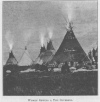
Click to enlarge
WOMEN SEWING A TIPI COVERING.
gossiping, smoking, and eating while at their work, much after the fashion of the neighbourly quilting bees of our grandmothers. The tipi coverings were so large and heavy that it would have been impossible for one woman to do the work alone. Joint labour was a necessity, at the same time furnishing a means of social enjoyment. When the group had finished one tipi they
moved on to help another woman, who was waiting for their assistance on her tipi covering.
Not only the manufacture, but also the keep—the "pitching" and "striking" of the tipi, was the office of women. They became so expert in both, that either was the work of only a few minutes. In former days, when buffaloes were numerous, the Blackfeet made

Click to enlarge
WOMEN PITCHING A TIPI.
(Lifting the covering into place.)
their tipis of buffalo skins. They now use canvas, or duck. The skins were tanned white but, in use, became smoke-coloured in the upper part of the tipi. When a lodge covering was discarded, it was cut up for moccasins, because they would not harden or shrink.
It required eight buffalo skins to make a small lodge, and from twenty to thirty to make a very large one. The average size was about sixteen feet in diameter
at the base, while large ones measured twenty-five feet. From fourteen to twenty-six poles were used for the supporting framework, and two others as "ear-poles" for facilitating the escape of smoke. The best poles are made of the slim and straight mountain pines, which the women cut and peel and season slowly, to keep them straight. Their length varies from fifteen to thirty feet according to the size of the tipi. A good set of poles having been secured, it is carried everywhere in their wanderings.
The following method of pitching a tipi was taught me by the Blackfeet. Four poles of equal length were selected. Lashing them together near their tops with a strong cord, we stood them up like a tripod and spread out their butts on the ground, very much on the same principle as the stacking of arms, with fixed bayonets, by infantry. This made a firm basis or skeleton for the completed framework. The other poles were then placed around, equi-distant from each other, their tops falling into the forked seat, made by the crossed tops of the four poles first put into place. Then, spreading the canvas covering upon the ground, we tied a pole to its middle and raised it to its proper position against the standing poles. The covering was then drawn around the framework of poles and the two ends were pinned together above the door opening in front, with seven slender sticks, or keys. By spreading out the poles uniformly at the base, the tipi was made symmetrical and by pegging the canvas down tightly all around, it was made to fit snugly. Last of all the two "ear-poles" were put in position, suited to the direction of the wind, and regulating the draught of the smoke-hole at the top. Inside, the fire-place occupied the centre, being made of stones, to confine
the fire in a small circle. Around it were placed the beds, provisions and cooking utensils. There was keen rivalry among the women in the matter of pitching the first new tipi in the spring, also as to who would excel in having the neatest tipi and the best tanned robes and skins.
Although it was customary for Indian women to
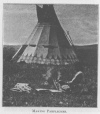
Click to enlarge
MAKING PARFLECHES.
perform the menial work, while men filled the more exalted vocation of providing and defending, yet it is a mistake to conclude that Blackfeet women rebelled against their lot. A Blackfoot mother conscientiously trained her daughter from childhood in the tanning of hides and converting them into clothes and shelter, the making of lodges and travois, and in the knowledge of herbs and wild vegetables used for eating and healing.
[paragraph continues] Women considered that this work was their rightful vocation and allowed no interference from the men of the family. In fact as the men lacked the necessary training they naturally were unfitted for these tasks.
The superiority of women in all household arts, which was developed by careful training from childhood, was

Click to enlarge
WOMAN CARVING A POLE.
(Used inside as part of a lodge-back.)
a marked feature of their social life. The same idea is suggested in a very primitive and curious Blackfeet legend, which tells of a period before the institution of the family, when men and women lived in separate camps. It describes the clothes and lodges of the men as poor compared with those used by the women, and
alludes to the great benefits resulting to the men, after the women chose them as mates.
In front of the war-tipi several women were engaged in drying and smoking meat upon poles erected for the purpose. From the time, when the men killed the game, the cutting of the meat, packing it on horses into camp, curing it, and finally cooking it, all was the work
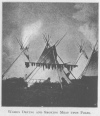
Click to enlarge
WOMEN DRYING AND SMOKING MEAT UPON POLES.
of women. The preparing of pemmican, the Blackfeet's "staff of life," a palatable form of condensed food, which was used for long journeys and for winter supplies, was also their duty. Their method of preparing it consisted, first, of cutting the meat into strips and drying it in the sun. It was then well pounded in a mixture together with wild cherries. To this was added
shredded meat, forming a kind of mince-meat, which was again dried and stored in parfleches for future use.
The Blackfeet subsisted mainly upon buffalo meat, when it could be secured. They also used sarvis berries, wild cherries, buffalo berries and vegetables such as camass, wild turnips, wild onions, wild potatoes, bitter root and wild rhubarb. They secured wild ducks and geese by striking them over the head with long sticks. Beaver tails were considered a great delicacy. They
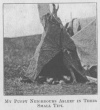
Click to enlarge
MY PUPPY NEIGHBOURS ASLEEP IN THEIR SMALL TIPI.
snared rabbits with willow sticks and fish with horse-hairs, but did not often eat them, because they preferred meat, which was abundant. They ridiculed the custom of eating dogs practised by the Crees, Gros Ventres and Assinniboines. The Cree Indians were not particular as to their diet for they are said to have eaten skunks, badgers, prairie dogs and even wolves and coyotes.
I once had an opportunity to witness the preparation of a dog feast by a band of Assinniboines, who were visiting in a Blackfeet camp. It happened that my
lodge was next to Eagle Child's, who was the owner of a litter of fat puppies. He had erected close by, a small tipi where they slept, and they played daily before my door. One night the puppies suddenly disappeared, Eagle Child himself could not explain what had become of them. The mystery, however, was solved when I went to call upon the Assinniboines. I saw that some of
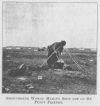
Click to enlarge
ASSINNIBOINE WOMAN MAKING SOUP OUT OF MY PUPPY FRIENDS.
my puppy neighbours had already been cut up and were boiling in a large pot, while others lay in the hot ashes to have the hair singed off. Nothing was wasted. Near by was a collection of small legs and feet which were to be used for soup and was afterwards described in jest by my Blackfeet friends as "the puppy paw soup of the Assinniboines."